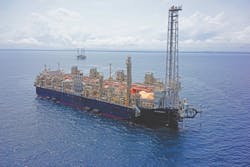Argentina doubles gas liquefaction capacity with FID on second FLNG
Key Highlights
- The MKII FLNG vessel will operate alongside Hilli Episeyo, both sourcing gas from the Vaca Muerta shale formation.
- Argentina aims to strengthen its role in regional natural gas and global LNG markets, supplying Asia and Europe and reducing energy trade imbalances through strategic infrastructure development.
Southern Energy SA (SESA), the consortium formed by Pan American Energy Corp., YPF SA, Pampa Energía SA, Harbour Energy PLC, and Golar LNG Ltd., has confirmed final investment decision (FID) to install a second floating LNG (FLNG) plant in Argentina. The vessel, designated MKII, will be deployed off the coast of Río Negro, Argentina, by late 2028 and will operate alongside Hilli Episeyo, which is scheduled to begin operations fourth-quarter 2027.
With both vessels online, the Argentina LNG 1 project will double its production capacity to 6 million tonnes/year (tpy), equivalent to about 27 million cu m/day of natural gas, for export.
Staggered investment structure
Total investment across floating infrastructure, logistics, operations, and support is estimated at more than $15 billion over the 20-year lifespan of the project. The first phase (2024–31) will require roughly $3.2 billion, while the second phase (2032–35) will account for an additional $2.8 billion.
Both FLNG will be operated by Southern Energy, enabling process integration, operational synergies, and optimization of LNG loading, storage, and export logistics. The consortium projects cumulative exports exceeding $20 billion between 2027 and 2035.
FLNG plants
Hilli Episeyo was converted by Golar LNG in 2017 from a hull originally built in 1975. It currently operates offshore Cameroon. It has a nominal capacity of 2.4 million tpy. It will be moored in Golfo San Matías. MKII, originally built in 2004 as an LNG carrier, is undergoing conversion at CIMC Raffles shipyard in China. It will have liquefaction capacity of 3.5 million tpy.
Both floating units will be supplied with gas from Neuquén basin—primarily from the Vaca Muerta formation—via infrastructure that will allow year-round operations. Initially, Hilli Episeyo will receive gas through the San Martín pipeline, transporting gas from Austral basin through a swap mechanism until dedicated infrastructure is completed to handle shale gas processing from the Neuquén formation.
Strategic global play
The project marks a milestone for Argentina, which is positioning itself as a structural supplier in the global LNG market amid rising international competition, supply diversification, and energy transition.The floating model offers strategic advantages over onshore liquefaction plants, including lower initial capital expenditure, faster implementation timelines, and greater operational flexibility. It also circumvents regulatory and environmental bottlenecks typically associated with land-based plants.
Regional LNG markets are consolidating, with countries like Brazil and Chile expanding import capacity and diversifying supply sources. Argentina’s ability to supply LNG to Asia and Europe strengthens its goal of monetizing surplus production from Vaca Muerta and reducing energy trade imbalances.
The project operates within a regulatory framework that, while still requiring adjustments to incentivize long-term exports, has begun to show signs of stability in contracts, transportation, and foreign currency regulations. The involvement of YPF and major international players improves the project’s overall risk profile.
YPF earlier this week acquired interests in two Vaca Muerta blocks from TotalEnergies SE (OGJ Online, Aug. 6, 2025).
About the Author
Camilo Ciruzzi
South America Correspondent
Ciruzzi is a journalist based in the Argentine province of Río Negro. He has over 30 years of experience in radio and print media. Ciruzzi studied Communication Sciences at the University of Buenos Aires and specialized in energy, political economy, and finance.
